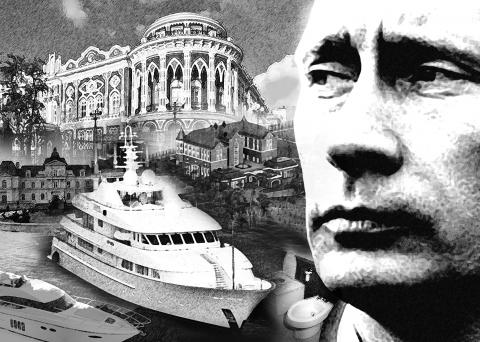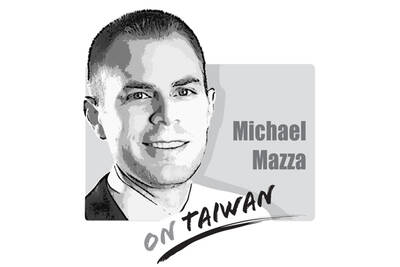To hear Russian President Vladimir Putin tell it, he works like a “galley slave,” pouring blood, sweat and tears into toiling for the Russian people with little personal gain in return.
Yet according to a new report by some of his harshest critics, Putin may be the richest “slave” in the world, reaping official perks as the powerful leader of a country with a long history of enriching its omnipotent tsars.
Watches in white gold, yachts decked out in the plushest of drapery and at least one flying toilet worth US$75,000 are among the presidential perks detailed by Boris Nemtsov, a former deputy prime minister turned Putin critic, and his co-author Leonid Martynyuk, a member of the opposition Solidarity movement, in a report released on Tuesday.

“Putin has led Russia for more than 12 years,” the authors wrote. “Losing popularity, Putin is maniacally clinging to power. It’s clear why.”
It is not just the “fear of losing his freedom, capital and property” or the influence of his inner circle, who have grown fantastically rich under his rule, they said. “One of the most serious reasons that forces Putin to hold on to power is the atmosphere of wealth and luxury to which he has become accustomed and which he does not want to give up.”
According to the authors, Putin has overseen a phenomenal expansion in the awarding of presidential perks. At his disposal are 20 palaces and villas, a fleet of 58 aircraft, a flotilla of yachts worth about 3 billion roubles (US$92.6 million), a watch collection worth 22 million roubles and several top-class Mercedes cars.
“We did not publish data on the cost of the clothes and things that Putin regularly uses: the suits, shoes and ties worth tens of thousands of dollars — mere trifles when compared to the villas, aeroplanes watches and cars,” they wrote.
The report, ironically titled The Life of a Galley Slave, is the latest salvo in the opposition’s attempt to discredit Putin as they continue to challenge the legitimacy of his return to the presidency this year. It could signal an attempt to expand the opposition beyond the urban middle class that comprises most of its ranks, highlighting the stark contrast in the way Putin lives compared with the average Russian.
“In a country where more than 20 million people can hardly make ends meet, the luxurious life of the president is a blatant and cynical challenge to society by a limitless ruler,” the report said.
With photographs of each palace, watch and aircraft, the report paints a colorful picture of the life enjoyed by Putin, and famously compared himself to a “galley slave” during a 2008 press conference.
There are the columned facades of palaces outside Moscow, in the southern resort of Sochi, and dozens more around the country. On an island in the center of Lake Valdai, stands a 930 hectare estate serviced by a 1,000-strong staff that includes a “presidential church, swimming pool, two restaurants, movie theater, bowling alley and concrete helipad.”
The authors compare Putin’s nearly two dozen official residences to the number held by other state rulers — two for the leaders of the US and Germany, and three for the president of Italy. Nine of the villas were built while Putin was at the helm of the country, they added.
The Russian president has long attempted to present an image of average Russian machismo, staging regular photo ops with factory workers and bikers. Images of his stark home life stand in contrast to the meetings he holds in the Kremlin’s gilded halls. During a televised meeting of his participation in Russia’s nationwide census in 2010, Putin appeared on a drab beige sofa in one of the two modest apartments he is officially registered as owning.
Putin last declared his income — US$115,000 — in December, a requirement to run in the March presidential vote, when his bank balance was revealed to be a mere US$179,612.
“And yet,” the authors said, “his lifestyle can be compared to the life of a Persian Gulf monarch or a flamboyant oligarch.”
Putin’s spokesman, Dmitry Peskov, could not be reached for comment. He has in the past called rumors of Putin’s personal wealth, revealed in diplomatic cables released by WikiLeaks, “completely stupid.”
Nemtsov and Martynyuk say the 58 aircraft Putin has access to comprise 43 planes and 15 helicopters. One of the airplanes, an Ilyushin-96, features an US$18 million cabin fitted out by jewelers and is said to have a toilet that costs US$75,000 alone. The report reveals four yachts, including the Olympia, which the authors dub “the real diamond in the Kremlin flotilla.” Fitted in rich mahogany, the five-floor yacht includes a jacuzzi and marble bathroom and costs US$50 million to maintain yearly, they allege.
The authors do not touch on Putin’s alleged personal wealth, instead highlighting how his lifestyle was afforded by taxpayer money which they say could have been better spent on improving the lives of the country’s citizens. Their report, dotted with footnotes, was mainly compiled from media reports.
“We absolutely cannot put up with this,” the authors wrote. “We think the lifestyle of those in power must become a subject of public discussion.”
Putin has attempted to maintain strict secrecy over his private life, with reports on his little-seen wife and two daughters considered all but taboo.
Speaking to a press conference in 2008, he said of his first two four-year terms as president: “All these eight years, I have labored like a galley slave, with all my strength. I’m pleased with the results of my work.”
The US Senate’s passage of the 2026 National Defense Authorization Act (NDAA), which urges Taiwan’s inclusion in the Rim of the Pacific (RIMPAC) exercise and allocates US$1 billion in military aid, marks yet another milestone in Washington’s growing support for Taipei. On paper, it reflects the steadiness of US commitment, but beneath this show of solidarity lies contradiction. While the US Congress builds a stable, bipartisan architecture of deterrence, US President Donald Trump repeatedly undercuts it through erratic decisions and transactional diplomacy. This dissonance not only weakens the US’ credibility abroad — it also fractures public trust within Taiwan. For decades,
In 1976, the Gang of Four was ousted. The Gang of Four was a leftist political group comprising Chinese Communist Party (CCP) members: Jiang Qing (江青), its leading figure and Mao Zedong’s (毛澤東) last wife; Zhang Chunqiao (張春橋); Yao Wenyuan (姚文元); and Wang Hongwen (王洪文). The four wielded supreme power during the Cultural Revolution (1966-1976), but when Mao died, they were overthrown and charged with crimes against China in what was in essence a political coup of the right against the left. The same type of thing might be happening again as the CCP has expelled nine top generals. Rather than a

The ceasefire in the Middle East is a rare cause for celebration in that war-torn region. Hamas has released all of the living hostages it captured on Oct. 7, 2023, regular combat operations have ceased, and Israel has drawn closer to its Arab neighbors. Israel, with crucial support from the United States, has achieved all of this despite concerted efforts from the forces of darkness to prevent it. Hamas, of course, is a longtime client of Iran, which in turn is a client of China. Two years ago, when Hamas invaded Israel — killing 1,200, kidnapping 251, and brutalizing countless others
A Reuters report published this week highlighted the struggles of migrant mothers in Taiwan through the story of Marian Duhapa, a Filipina forced to leave her infant behind to work in Taiwan and support her family. After becoming pregnant in Taiwan last year, Duhapa lost her job and lived in a shelter before giving birth and taking her daughter back to the Philippines. She then returned to Taiwan for a second time on her own to find work. Duhapa’s sacrifice is one of countless examples among the hundreds of thousands of migrant workers who sustain many of Taiwan’s households and factories,